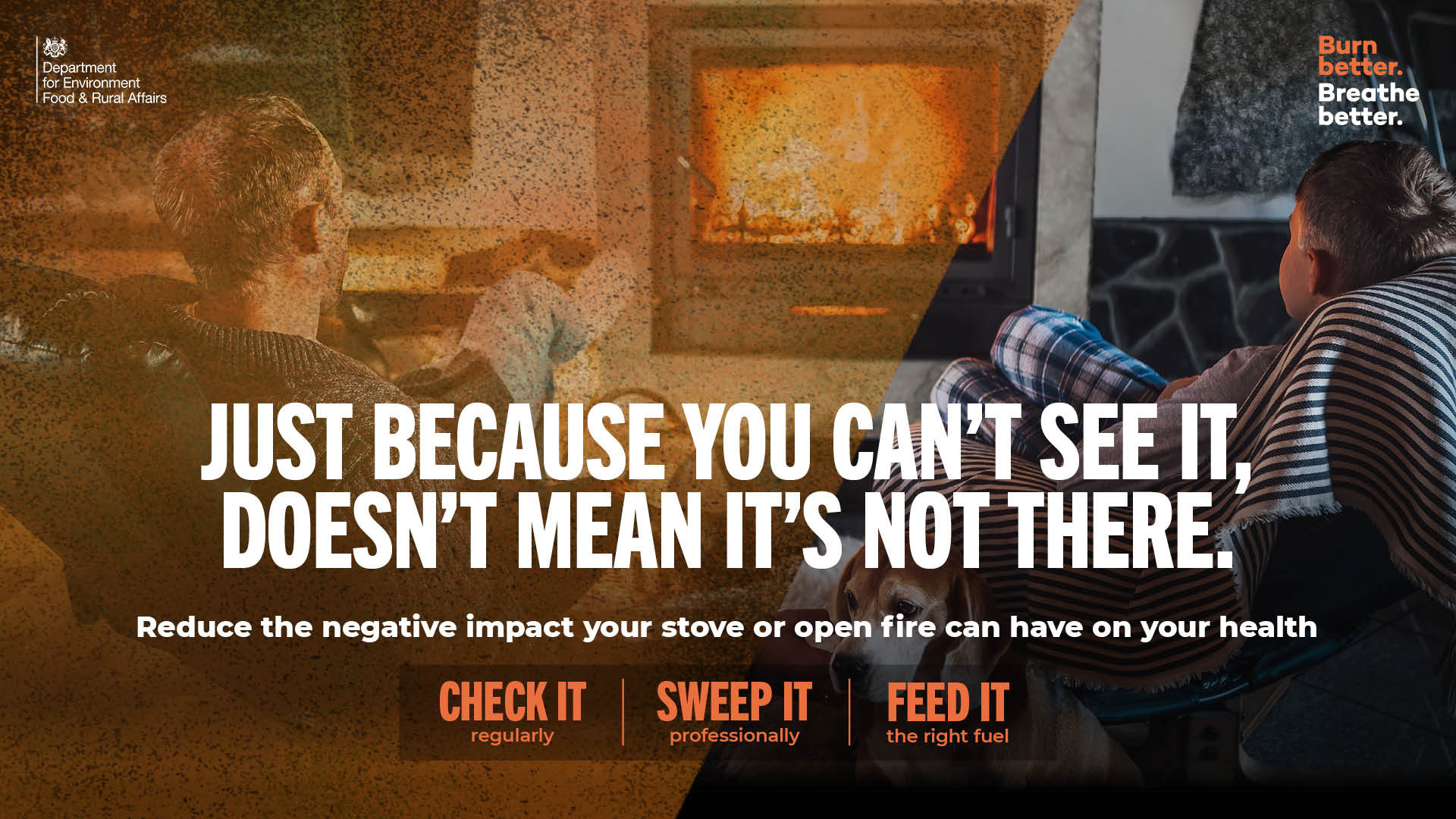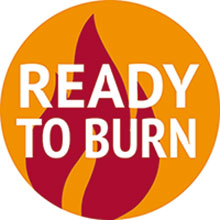Burn Better, Breathe Better: Reduce the negative impact your stove or open fire can have on your health

Find out how to burn better with your indoor stove or open fire. Make sure you:
Why is it important to improve the way we burn at home?
Air pollution is the biggest environmental risk to public health.
Using a stove or open fire at home is a major contributor of a pollutant called fine particulate matter (known as PM2.5). These tiny particles can damage your lungs and other organs and can be harmful to your health.
Making small changes to how you burn can provide benefits such as:
- Improving the air we all breathe by reducing the amount of pollution produced.
- Keeping you and your family safe by reducing the risk of chimney fires.
- Helping you get the most out of your stove or open fire so that it performs better - by using less fuel to produce more heat.
How to burn better
Here are steps you can take to burn better for the environment, the community and for your health.
Check it regularly
Regular maintenance of your stove or open fire means it will perform better, use less fuel to produce more heat, and produce fewer harmful particles.
To properly maintain your stove, you should:
- Get your stove installed by an installer registered on a competent person scheme certified by one of the following organisations: HETAS, APHC, BESCA, Certsure, NAPIT or OFTEC.
- Get your stove serviced once a year. If you’re unsure whether your current system was installed correctly, you can get this checked at your annual service.
- Always use your stove in line with the manufacturer and installer’s guidance, including only burning suitable fuels.
In addition, there are actions you can take to help maintain both your stove or open fire.
You should regularly:
- Clean out the ash.
- Check firebricks for cracks.
- Clean the stove glass.
- Check the seal around the stove door.
- Clean the outside of stove or open fire.
Sweep it professionally
An important part of maintaining your stove or open fire is getting your chimney swept at least once a year by a chimney sweep. Soot and tar build up in your chimney over time, reducing its efficiency and increasing the risk of chimney fires.
Putting a reminder in your calendar is a useful way to remember to get your chimney swept each year.
Find a chimney sweep through:
Feed it the right fuel
To help improve the air we breathe and ensure householders choose cleaner fuels, sales of traditional house coal and wet wood (the two most polluting fuels) have been phased out in England.
Cleaner alternatives, such as dry wood and manufactured solid fuels, produce less smoke and pollution than wet wood or traditional house coal and are cheaper and more efficient to burn.
You should always check which fuel types are recommended for your appliance. Using the wrong fuel could damage your appliance, affect your chimney, and invalidate your warranty.
Which fuels should I burn?
Ready to Burn

If you buy fuel accompanied by the 'Ready to Burn' logo, you can be confident that you are choosing the cleanest available fuels and reducing the risk to yourself and your family. The Ready to Burn logo shows that:
- Wood (sold in volumes of less than 2m3) has a moisture content of 20% or less.
- Manufactured solid fuels (such as briquettes and fire logs) meet sulphur and smoke emission limits.
You can find the logo on the fuel's packaging, alongside it on the shelf or next to the price. This will be accompanied by the manufacturer or supplier’s details and a certification number.
Wood
Make sure any wood you burn at home is dry (this means it has a moisture content of 20% or less). When burnt, wet wood with a moisture content above 20% produces lots of smoke, particles and tar deposits which can damage your health and the environment. This can also damage your appliance and chimney, increasing maintenance costs and the risk of chimney fires. Dry wood produces less smoke and has better heat efficiency.
If you buy wood in volumes under 2m3, you can check the wood has less than 20% moisture by seeing if it has the 'Ready to Burn' logo.
If you buy wood in volumes over 2m3 or source your own wood, you should:
- Store it in a dry area, allowing the logs to air dry for at least 2 years before burning.
- Use a moisture meter to check that moisture levels are 20% or less before burning.
- Check for signs your wood is ready to burn if you cannot use a moisture meter:
- Weight – when comparing similar sized logs and the same species, if the log is heavier this can indicate it is still wet.
- Sound – a hollow sound when tapping indicates dry logs.
- Cracked ends – can indicate dry logs.
- Bark – the looser the bark the drier the log.
- Colour – dry wood can be lighter in colour.
- Where possible, look for sustainability sourced wood by checking it comes from a sustainably managed woodland that is nearby.
- Do not burn treated wood, such as painted, stained or chemically treated wood (which includes old furniture, pallets and medium density fibreboard). These release dangerous pollutants which could have a serious impact on human health.
Whether you buy wood or source it yourself, the Forestry Commission has more information on choosing and drying logs (PDF).
You can find your local wood supplier through the Ready to Burn website.
Manufactured solid fuels
Manufactured solid fuels are available in a range of forms, such as briquettes and fire logs.
Before purchasing manufactured solid fuels, check your stove’s manual to make sure which specific fuels can be used. Incorrect use can cause damage to your appliance.
Again, you should look for the approved 'Ready to Burn' logo. The logo confirms that the fuel meets the sulphur and smoke emission limits and can be legally sold for use in domestic premises – with some limited exemptions.
Check this list of fuels that are approved for burning in smoke control areas and can be used more widely.
These manufactured solid fuels are exempt from the Ready to Burn certification requirements:
- Coffee logs.
- Olive logs.
- Wine logs.
- Fuels where they are mostly made of wheat husks, straw, miscanthus, bamboo or compressed food waste.
Coal
The World Health Organization classifies coal smoke as a carcinogen. You can no longer buy the most polluting coal (bituminous/traditional house coal) for domestic use.
If you used to burn traditional house coal, consider switching to alternative types of coal such as anthracite, semi anthracite and low volatile steam coal. These smokeless coals produce less harmful particulates and can be used in smoke control areas.
Traditional house coal extracted and sold from the Forest of Dean is exempt. This can continue to be sold locally.
Further information and useful links
Am I in a smoke control area?
Parts of the UK are smoke control areas. There are additional regulations that apply to burning in these areas and you could be committing an offence if smoke is released from the chimney of your home. Check the smoke control area map to see if you are in a smoke control area.
You can find more information on the rules on GOV.UK
What stove should I use?
There are rules on the types of stoves you should use in smoke control areas if using certain fuels, information can be found GOV.UK
You may want to consider using an Ecodesign stove. Since January 2022, new stoves entering the UK market must be Ecodesign compliant. They produce lower emissions and are more efficient than non-Ecodesign stoves and open fires.
Alternatively, contact your stove manufacturer for their recommendation.
Useful links
- Watch a video on good burning practices.
- Find advice about solid fuels, safety and energy efficiency at the Solid Fuel Association website.
- See advice leaflets on a range of topics on the HETAS website.
